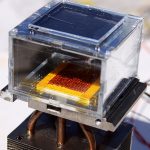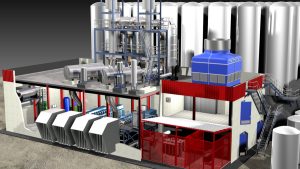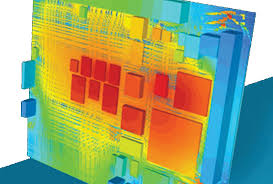Smart Transformers Will Make the Grid Cleaner and More Flexible
It would be hard to overstate the importance of transformers in our electrical networks. They’re literally everywhere: on poles and pads, in substations and on private property, on the ground and under it. There are probably dozens in your neighborhood alone. It’s hard to imagine a world without them. But my colleagues and I are doing just that.
In the distribution system, transformers typically take medium, or “primary,” voltages measured in the thousands of volts and convert them to secondary voltages—such as 120, 240, or 480 volts—that can be safely delivered to homes and businesses all over the world. It’s an approach that’s been used since before alternating current won the war of currents in 1892. It is difficult to name another electrotechnology that has survived as long.
Nevertheless, it is time to start thinking beyond the conventional transformer. For one thing, transformers are bulky. They’re often cooled with oil, which can leak and is difficult to dispose of safely. Crucially, transformers are passive, one-way tools. They aren’t designed to adjust to rapidly changing loads. This shortcoming will fast become intolerable as distributed power sources such as wind turbines, solar panels, and electric-vehicle batteries feed more and more energy to the grid.
Happily enough, research into a new kind of technology—one that could address all of these limitations—has been making significant strides. Thanks to recent advances in power electronics, we can now contemplate building smart, efficient “solid-state transformers,” or SSTs. They promise to handle tasks that are difficult if not impossible for a conventional transformer to accomplish, such as managing the highly variable, two-way flow of electricity between, say, a microgrid and the main grid. What’s more, these smart transformers can be modular, making them easy to transport and install. And they can be significantly smaller than an equivalent conventional transformer—with as little as about half the weight and a third the volume.
In the near term, SSTs could be a boon for disaster-recovery efforts in places with damaged electrical infrastructure and for settings such as naval vessels, where volume and weight are at a premium. Further in the future, they could redefine the electrical grid, creating distribution systems capable of accommodating a great influx of renewable and stored energy, dramatically improving stability and energy efficiency in the process.
Alternating-current networks rely on voltages in the hundreds of thousands of volts to transmit power over long distances. But as the current gets closer to its loads, the voltage needs to come down again. Thus transformers are used throughout the grid, to step up the electricity exiting a power plant to a high voltage so that it can be transmitted with great efficiency, and to step it down at the distribution end, to the levels appropriate to power factories, businesses, and homes.
Although the transformer has been improved many times over the years, it is essentially a 19th-century technology, one that takes advantage of simple principles of electromagnetism. In the most basic version, two coils are wound around a magnetic core. Because the alternating current going through one coil of wire—the primary—varies with time, it produces a magnetic field in the core that also varies in time. That changing magnetic field in turn induces an alternating current and voltage in another coil—the secondary. The ratio of the input, or primary, voltage to the output, or secondary, voltage is determined by the ratio of turns in the primary and secondary coils.
Transformers have a number of great properties. They are efficient and rugged, and they offer a very useful feature called galvanic isolation. Because the input and output sides of a transformer are linked only by magnetic fields, there is no way for current to flow directly across the device from the primary to the secondary side. This isolation is an important safety feature that helps prevent high-voltage electricity from reaching places it shouldn’t go.
Some transformers are capable of handling a measure of variability. Distribution transformers can be equipped with a tap changer, which mechanically toggles between different parts of a coil, reducing or increasing the number of turns in order to decrease or increase the voltage in response to big changes in load.
But these tap-equipped transformers are not well suited to the frequent and large voltage swings that can occur nowadays. Instead of changing once or twice a day, as they did years ago, tap changers can now easily change position upwards of a dozen times, resulting in significantly more wear and tear.
If we could design a transformer that doesn’t need a mechanical tool to adjust its voltage, we could eliminate a significant expense in distribution infrastructure. The natural solution, of course, is to apply the best appropriate technology—namely power electronics.
And in fact, a number of engineers are exploring the idea of a “hybrid transformer,” which adds power electronics to assist in controlling voltage. But new, high-voltage semiconductor devices are needed if we want to create more capable electronic distribution transformers. And until recently, there were no switches that had all the right properties.
Thyristors, for example, can be used to build converters that can be connected to high-voltage lines. But the converters would take up a lot of space. That’s because thyristors aren’t designed for high-frequency operation. The lower the frequency, the larger the system’s passive elements—in particular, the inductors and capacitors—need to be. You can think of these components as charge-storage devices; the lower the frequency, the longer they need to accommodate charges flowing through them, which means they need to be fairly big.
The workhorse switch of power electronics, the silicon-based insulated-gate bipolar transistor (IGBT) is a better fit. These devices have been used to build SSTs for rail applications in Europe. And they are certainly faster. But the most rigorous commercial devices can withstand voltages up to only about 6.5 kilovolts. While this breakdown voltage is perfectly fine for a range of power applications, it isn’t sufficient to handle the electricity that flows through distribution transformers; in the United States, a typical voltage at the low end of the spectrum is 7.2 kV.
Of course, if a few of those IGBTs were connected in series, they could be used to create an SST that can handle the voltage. But small manufacturing variations mean each IGBT will switch at a slightly different voltage, and that means some transistors will switch earlier than others, bearing more of the load. Capacitors can help equalize the voltages, but the result would be bulky, inefficient, less reliable, and more expensive.
Fortunately, silicon is not the only option. In the last 10 years, great strides have been made in the development of switches based on compound semiconductors—silicon carbide in particular. Silicon carbide has a range of attractive properties that stem from its large bandgap—the energy hurdle that must be overcome to switch from insulator to conductor. Silicon carbide’s bandgap is 3.26 electron volts to silicon’s 1.1 eV, which means the material can be exposed to significantly higher electric fields and temperatures than silicon can without breaking down. And because this compound semiconductor can withstand much higher voltages, power transistors built from it can be made more compact, which in turn allows them to switch much faster than their silicon-based counterparts. A faster switching speed also cuts down on energy loss, so silicon carbide transistors can carry more current for a given thermal budget.

Inspired by developments in silicon carbide devices and by related research funded by the U.S.-based Electric Power Research Institute, a group of us at North Carolina State University applied in 2007 for a grant from the U.S. National Science Foundation. We used the grant to start the Future Renewable Electric Energy Delivery and Management (FREEDM) Systems Center, with the aim of advancing the technologies we’ll need to modernize the electrical grid, making it more secure, reliable, and environmentally sustainable.
SSTs were a big priority for the center, and we aimed to tackle both single-phase and three-phase distribution transformers. To understand the difference, here’s a little background. The energy that flows out of substations is generally carried by three wires, each carrying an alternating current that is 120 degrees out of phase with respect to the other two. These lines can be separated and passed individually (along with a neutral line) through a single-phase transformer to supply fairly low-voltage electricity to residential neighborhoods, for example. Or the lines can be carried together in a three-phase feeder to places that have bigger energy demands, such as data centers, factories, commercial buildings, and retail complexes.
At FREEDM, we started by working on SSTs designed to handle that lower-voltage, single-phase service. The transformers are similar in some respects to switched-mode power supplies, which are now ubiquitous as power sources for laptop computers and other appliances.
Our approach has been to build the SSTs from three modules. The first, called a front-end converter, takes incoming alternating current at, say, 7.2 kV and converts it to direct current (because of the particulars of our design, that DC current has a somewhat higher voltage). The AC-to-DC conversion is done using a set of power transistors. In the first incarnation, this was done with silicon IGBTs, and in our second SST, we did it with an early silicon carbide switch: the silicon carbide metal-oxide-semiconductor field-effect transistor, or MOSFET.
To convert the incoming electricity—which oscillates at 60 hertz in the United States—into a DC current requires two complementary sets of transistors. One set is in operation when the incoming AC electricity has a positive voltage, and the other set is in operation when it has a negative voltage. Thanks to the way the transistors are wired up, regardless of the voltage of the incoming electricity, charge piles up on a capacitor, which is steadily discharged to create DC current. We use transistors to perform this rectification process instead of traditional diodes because we can run them at many times the incoming frequency. This lets us chop up the sinusoidal incoming current very finely so that we don’t inject noise and unwanted harmonics upstream. That would create deviations from clear sine waves in voltage and current, and thus unusable energy that would be lost to heat.
In the second module, another set of transistors converts incoming DC current into an AC current with a frequency measured in kilohertz. This current is then passed through a conventional—though high-frequency—transformer to convert the voltage down to, say, 800 V.
Why the high frequency? Basically, the size of a transformer is inversely related to the frequency of the voltage it must transform. The higher the frequency, the smaller the transformer—and, as a bonus, the more efficient it will be. After the voltage is reduced, a set of lower-voltage devices converts this still-high-frequency AC current back to a direct current.
The third module is an inverter, which uses yet another set of transistors to convert the DC electricity back to AC with a mains frequency, at which point it can then be safely supplied to end users.
The first single-phase SST we built was designed to explore silicon’s limits; the second allowed us to put silicon carbide devices through their paces. And if there was any doubt about the benefits of silicon carbide over silicon, it could be resolved by comparing those two SSTs. Our silicon-based transformer needed three sets of silicon IGBTs arranged in series to convert incoming 7.2-kV electricity down to the standard 120- and 240-V output, and could operate only up to 3 kHz. At that frequency, the conventional transformer was smaller, but we needed three of them. The silicon carbide version could accomplish the same task with one set of transistors, and it could operate at 20 kHz—a frequency that enabled us to use a transformer in the second module that was just 20 percent the size of a conventional 60-Hz transformer. All told, our single-phase silicon carbide SST was a third the size of its conventional counterpart.
So, in the end, did we simply take one big transformer and replace it with a smaller one with a lot of costly electronics? Not exactly. Like the hybrid transformer, the transformer we created can automatically and quickly adjust to shifts in voltage over a wide range, eliminating the need for mechanical tap changers. But it is also a smart energy-management device that can handle a wide range of loads and sources, providing much better flexibility and resilience than a conventional or hybrid transformer.
With the three-module approach, batteries and renewable energy sources can connect directly to one side of the SST’s central module. As a result, those energy sources can have a direct DC interface with the grid. This arrangement will significantly decrease how much energy is lost when solar panels, wind turbines, and the like pump energy back on the grid, as the electricity they generate won’t need to be converted into an alternating current in order to pass through nearby transformers.
Our work on single-phase SSTs motivated us to extend our efforts to build a three-phase SST. This would mean creating a transformer that can handle all three of the lines that are leaving the substation or are carried along a distribution feeder circuit. A common input voltage there is 13.8 kV, which is converted down to 480 V for industrial and commercial uses.
Here, at this relatively high voltage, silicon carbide MOSFETs weren’t the best choice; they lose a lot of energy when current is flowing through them, and the loss gets worse the higher the voltage and temperature. Fortunately, a corporate partner near the university, Cree, had been working on silicon carbide IGBTs. These lose more energy than MOSFETs do when they’re switching, but they can carry more current through the same area and so be even more compact.
In 2010, the U.S. Department of Energy’s Advanced Research Projects Agency-Energy awarded our team US $4.2 million to build a three-phase SST from these devices. We called the project the Transformerless Intelligent Power Substation, or TIPS. I’ll admit it is a somewhat odd moniker: TIPS is not a substation, nor does it lack a transformer. But the “substation” part of the name came about because we wanted to emphasize how smart and capable an SST could be. And “transformerless” really refers to the idea of using less of the conventional transformer technology by operating at a fairly high frequency.

With so many different conversion steps, you might think that SSTs such as TIPS are significantly less efficient than conventional transformers. But they actually perform quite well. Transformers today have an efficiency of more than 99 percent when they’re operated at full capacity, with less than 1 percent of the electricity lost to heat. But the efficiency drops down to 95 percent for a transformer operating at 30 to 50 percent of capacity. For contrast, we expect SSTs such as TIPS to have an efficiency of 98 percent, regardless of load. What’s more, by fluidly adjusting voltage, an SST can reduce the reliance on boosting current—a highly inefficient remedy that is used today to make sure enough power reaches a user even if the voltage drops on a line.
Ours is not the only team that has built SSTs. But with TIPS we were able to demonstrate what silicon carbide IGBTs have to offer: a new class of three-phase transformers that are simultaneously compact and ultracapable.
There are still obstacles to widespread adoption. One is the ability to withstand extreme conditions. Traditional transformers can handle lightning strikes and surges, overheating without failing. But power electronics are significantly less forgiving; the transistors are small and have little thermal inertia, which means they heat up almost instantaneously. Voltage-dependent resistors and surge arresters, installed at the high-voltage side of an SST, could help compensate for this limitation.
Another obstacle is cost. The silicon carbide IGBTs that we used to make TIPS were experimental devices not available commercially. Companies such as Cree, General Electric, Infineon, Mitsubishi, and Rohm are continuing to develop these devices. And Cree has since gone on to build 20-kV and 24-kV versions. These higher-voltage ratings could lead to SSTs that require significantly fewer devices, saving on cost and space. But silicon carbide IGBTs are still at an early stage of development, and their commercialization will depend in part on practicalities like the ability to manufacture them with fewer defects. It may be some years before silicon carbide IGBTs will be mature and thus inexpensive enough to produce an SST that could be offered at a competitive price.
In the meantime, our team has received significant support to investigate building SSTs using more mature 10-kV silicon carbide MOSFETs. These transistors must be connected in series to be able to withstand three-phase distribution voltages, and they won’t be as efficient as IGBTs. But they could still offer a path toward creating smaller transformers than we have today, with all the SST smarts and functionality we’ve demonstrated.
You may have noticed that if you lop off the outer modules of TIPS, you wind up with a DC-DC converter. If we had such converters in the early days of electricity, we may well have seen Thomas Edison’s DC distribution scheme contending with Nikola Tesla’s AC approach to this day. In the past few years, this old rivalry has again come to the fore. DC transmission promises fewer losses over long distances. And engineers are contemplating DC microgrids, to more efficiently power our DC-dependent appliances and everyday gadgets. We can now make DC-DC converters out of silicon power electronics that are efficient enough to be used for such microgrids; silicon carbide versions could have higher efficiency and even wider applications.
Few of these ideas are new. But they are taking on new urgency as we strive to make the most of our energy resources. SSTs offer a way to dramatically change how power makes its way to us. The changes they’ll effect won’t be as glamorous or as visible as the great leaps in electronics that have, in the last 50 years, revolutionized our daily lives. But they will have a profound impact on the stability and efficiency of our electrical infrastructure, finally bringing it—at long last—into the electronics age.
This article appears in the July 2017 print issue as “Transforming the Transformer.”
By



















No Comments